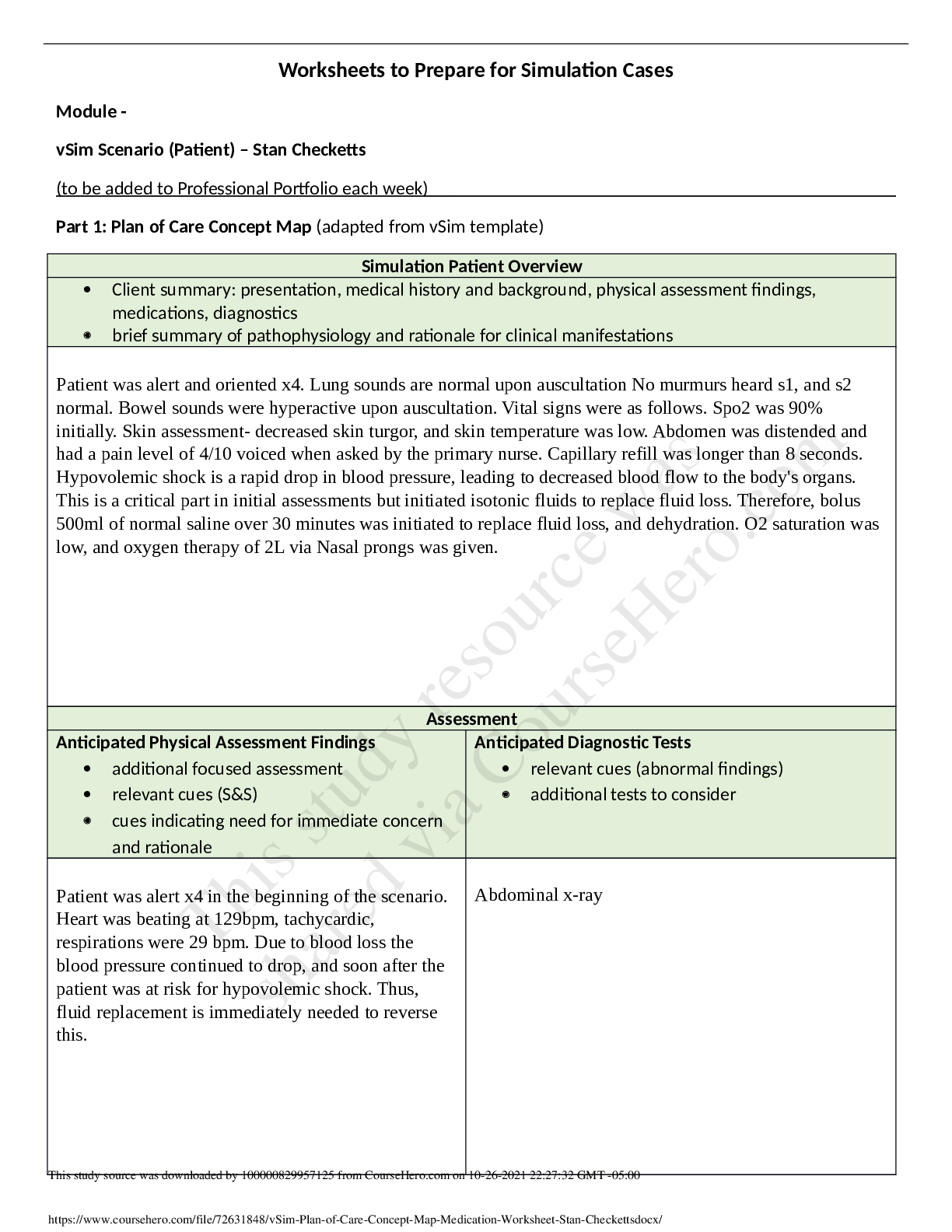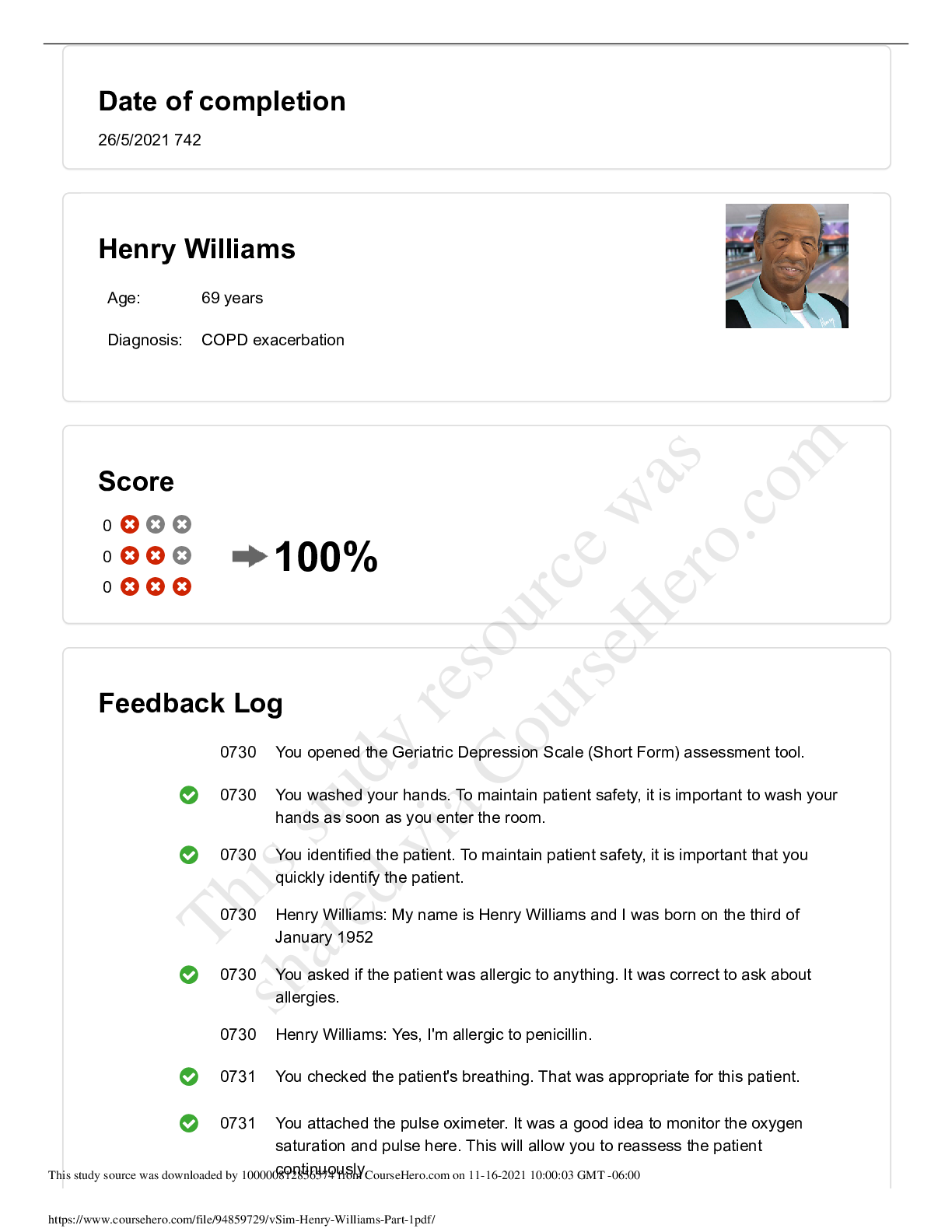*NURSING > vSim For Nursing > Worksheets to Prepare for Simulation Cases. Module - Gerontology vSim Scenario (Patient) – Henry (All)
Worksheets to Prepare for Simulation Cases. Module - Gerontology vSim Scenario (Patient) – Henry Williams Part 1 Part 1: Plan of Care Concept Map (adapted from vSim template).
Document Content and Description Below
Worksheets to Prepare for Simulation Cases Module - Gerontology vSim Scenario (Patient) – Henry Williams Part 1 Part 1: Plan of Care Concept Map (adapted from vSim template) Simulation Patient O... verview • Client summary: presentation, medical history and background, physical assessment findings, medications, diagnostics • brief summary of pathophysiology and rationale for clinical manifestations Henry Williams is a 69-year-old retired rail system engineer who lives in a small apartment with his wife. He was admitted during the night with progressive shortness of breath. His oxygen saturation on admission was 82% on room air. He has a history of COPD and coronary artery disease, and is hard of hearing. His oxygen saturation has improved and is now running 88% on oxygen 2 L/min by nasal cannula. His respiratory rate has been 24-30/min. Henry is concerned about his wife, Ertha, because she is experiencing frequent memory lapses. Ertha went home with their daughter-in-law, Betty, and they have just returned. Due to his shortness of breath the admission is not complete. A fall risk assessment has been done and indicates a moderate fall risk, but he still needs an overall assessment. Blood pressure has been 134/88 mmHg, pulse was 112/min, and respirations were 28/min. He is alert and oriented. The morning labs were just drawn, and the physician wants to know the arterial blood gases. Henry denies pain and says he is just tired. COPD is a preventable and treatable slowly progressive respiratory disease of airflow obstruction involving the airways, pulmonary parenchyma, or both (Hinkle & Cheever, 2018). Most patients with COPD present with overlapping signs and symptoms of emphysema and chronic bronchitis, which are two distinct disease processes (Hinkle & Cheever, 2018). COPD is generally a progressive disease characterized by three primary symptoms: chronic cough, sputum production, and dyspnea (Hinkle & Cheever, 2018). Assessment Anticipated Physical Assessment Findings • additional focused assessment • relevant cues (S&S) • cues indicating need for immediate concern and rationale • Chronic cough • Sputum production • Dyspnea • Weight loss • Work of breathing increases over time • Accessory muscles are used • Barrel chest thorax (Hinkle & Cheever, 2018) Plan Anticipated Care Priorities Anticipated Nursing Interventions • Activity intolerance r/t imbalance between oxygen supply and demand • Ineffective Airway clearance r/t bronchoconstriction, increased mucus, ineffective cough, infection • Anxiety r/t breathlessness, change in mental status • Impaired Gas Exchange r/t ventilation-perfusion inequality • Imbalanced Nutrition: less than body requirements r/t decreased intake because of dyspnea, unpleasant taste in mouth left by medications, increased need for calories from work of breathing • Powerlessness r/t progressive nature of disease • Self-Care deficit: r/t fatigue from increased work of breathing (Ackley, Ladwig & Makic, 2014) Part 1: Medication Worksheet (one per medication) (adapted from vSim template) Medication Classification Albuterol Bronchodilator / Beta Adrenergic Agonist Dose - PO, IV, IM.SC or most common route Route: PO, Inhalation (via Nebulizer) PO (Adults and Children >12 yr): 2–4 mg 3–4 times daily (not to exceed 32 mg/day) or 4–8 mg of extended-release tablets twice daily. PO (Geriatric Patients): Initial dose should not exceed 2 mg 3–4 times daily, may be increased carefully (up to 32 mg/day). PO (Children 6–12 yr): 2 mg 3–4 times daily or 0.3–0.6 mg/kg/day as extended-release tablets divided twice daily; may be carefully increase as needed (not to exceed 8 mg/day). PO (Children 2–6 yr): 0.1 mg/kg 3 times daily (not to exceed 2 mg 3 times daily initially); may be carefully increase to 0.2 mg/kg 3 times daily (not to exceed 4 mg 3 times daily). Inhaln (Adults and Children >4 yr): Via metered dose inhaler—2 inhalations q 4–6 hr or 2 inhalations 15 min before exercise (90 mcg/spray); some patients may respond to 1 inhalation. NIH Guidelines for acute asthma exacerbation: Children—4–8 puffs q 20 min for 3 doses then q 1–4 hr; Adults— 4–8 puffs q 20min for up to 4 hr then q 1–4 hr prn. Inhaln (Adults and Children >12 yr): NIH Guidelines for acute asthma exacerbation via nebulization or IPPB—2.5–5 mg q 20 min for 3 doses then 2.5–10 mg q 1–4 hr prn; Continuous nebulization— 10–15 mg/hr. Inhaln (Children 2–12 yr): NIH Guidelines for acute asthma exacerbation via nebulization or IPPB—0.15 mg/kg/dose (minimum dose 2.5 mg) q 20 min for 3 doses then 0.15–0.3 mg/kg (not to exceed 10 mg) q 1–4 hr prn or 1.25 mg 3–4 times daily for children 10–15 kg or 2.5 mg 3–4 times daily for children >15 k g; Continuous nebulization— 0.5–3 mg/kg/hr. Inhaln (Neonates): 1.25 mg/dose q 8 hr via nebulization or 1–2 puffs via MDI into the ventilator circuit q 6 hrs. (Vallerand & Sanoski, 2015) Purpose/Main Drug Actions Indications – Used as a bronchodilator to control and prevent reversible airway obstruction caused by asthma or COPD. Inhalation: Used as a quick-relief agent for acute bronchospasm and for prevention of exercise-induced bronchospasm Action – Binds to beta2- adrenergic receptors in airway smooth muscle, leading to activation of adenyl cyclase and increased levels of cyclic-3’, 5’-adenosine monophosphate (cAMP). Increases in cAMP activate kinases, which inhibit the phosphorylation of myosin and decrease intracellular calcium. Decreased intracellular calcium relaxes smooth muscle airways. Relaxation of airway smooth muscle with subsequent bronchodilation. Relatively selective for beta2 (pulmonary) receptors Therapeutic Effects – Bronchodilation (Vallerand & Sanoski, 2015) Nursing Considerations/Actions Nursing Implications • Assess lung sounds, pulse, and BP before administration and during peak of medication. Note amount, colour, and character of sputum produced • Monitor pulmonary function tests before initiating therapy and periodically during therapy Adverse Reactions • CNS: Nervousness, restlessness, tremor, headache, insomnia, hyperactivity in children. (Vallerand & Sanoski, 2015) ISBAR Worksheet (adapted from vSim) ISBAR Student Notes Introduction • Your name, position (Nursing student), unit you are working on • What is the purpose of this communication? Situation • What is happening at the moment? • Patient’s name, age, specific reason for visit/admission Background • What are the issues that led up to this situation? • Patient’s primary diagnosis, date of admission, current orders Assessment • What do you believe the problem is? • Current pertinent assessment data using head to toe or focused assessment approach, • Pertinent diagnostics • Vital signs Recommendation • What should be done to correct this situation? • Any orders or recommendations you have for this patient Opening Questions How did the simulated experience of Henry Williams’s case make you feel? What nursing actions did you feel were appropriate within this scenario? Scenario Analysis Questions* EBP What priority problem did you identify for Henry Williams? EBP What is the rationale for recognizing Henry Williams’s shortness of breath and for initiating actions in a timely manner? EBP What is the rationale for recognizing Henry Williams’s anxiety and concern for his wife and for initiating actions in a timely manner? PCC What teaching strategies and information should be included during Henry Williams’s visit to the clinic PCC/I What appropriate assessments were made to help you decide what interventions Henry Williams needed? T&C What was the relevance of the nursing communication with Henry Williams’s daughter-in-law, Betty? It is important to do this because including the family within the plan of care allows for more support for the patient if need be. T&C What health care team members and services may play a role in Henry Williams’s care and why? QI What actions should take place to improve Henry Williams’s quality of care? PCC How do you think Henry and Ertha Williams will be coping 1 month after the scenario? Concluding Questions Reflecting on Henry Williams’s case, were there any actions you would do differently? If so, what were these actions, and why would you have done them differently? References Ackley, B. J., Ladwig, G. B., & Makic, M. B. F. (2017). Nursing diagnosis handbook: An evidence-based guide to planning care (11th ed.). St. Louis, MO: Elsevier. Hinkle, J.L. & Cheever, K.H. (2018). Brunner & Suddarth's Textbook of Medical-Surgical Nursing (14th ed.). Philadelphia: Wolters Kluwer. Vallerand, A., & Sanoski, C. (2015). Davis’s Drug Guide for Nurses. (14th ed.). Philadelphia, PA: F. A. Davis Company. [Show More]
Last updated: 2 years ago
Preview 1 out of 6 pages

Buy this document to get the full access instantly
Instant Download Access after purchase
Buy NowInstant download
We Accept:

Reviews( 0 )
$13.00
Can't find what you want? Try our AI powered Search
Document information
Connected school, study & course
About the document
Uploaded On
Feb 24, 2021
Number of pages
6
Written in
Additional information
This document has been written for:
Uploaded
Feb 24, 2021
Downloads
0
Views
209










